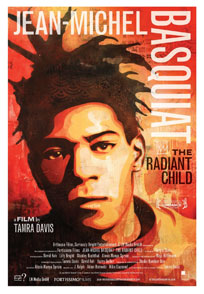|
Jean-Michel Basquiat: The Radiant Child
Jean-Michel Basquiat: The Radiant Child is a 2010 documentary film directed by Tamra Davis. It crosscuts excerpts from Davis' on-camera interview with the artist Jean-Michel Basquiat and anecdotes from his friends and associates. The film was shown at the Sundance Film Festival in 2010.[1] BackgroundTamra Davis was working in a Los Angeles art gallery in 1986 when she filmed an interview with her friend, Jean-Michel Basquiat.[2] After Basquiat's death from a heroin overdose in 1988, Davis stored the footage away. In 2008, Davis was encouraged by gallerists at the Museum of Contemporary Art to do something with the footage.[3] She began interviewing friends and associates of Basquiat's and pieced together a documentary.[2] The film is titled after an article about Basquiat written by art critic Rene Ricard for Artforum in 1981.[4] SynopsisIn the beginning of his 10-year career, Jean-Michel Basquiat was known for his graffiti art under the alias SAMO in Manhattan's Lower East Side in the late 1970s. He sold his first painting to Debbie Harry for $200, dated Madonna, and became a close friend and collaborator of Andy Warhol's.[1] Basquiat was launched into international stardom for his bebop-influenced neoexpressionist work. However, soon his cult status began to overshadow his art.[5] As a successful black artist, Basquiat was constantly confronted by racism and misconceptions. The Radiant Child draws from insider interviews and archival footage of Basquiat's telling his story in his own words.[1] People interviewed
ReviewsThe film received positive reviews, however, critics noted that it doesn’t fully explore why Basquiat's work was so "innovative in the New York art scene of the 1980s."[6] Slant Magazine wrote that "you see the paintings and hear people praise them, without the space to consider them in between, " adding: "The film's a decent introduction to a man who walked the world of SoHo, CBGB, and Andy Warhol's final days, but the more you know going into the movie, the more you sense it leaving out."[7] The Hollywood Reporter wrote: "Naturally, the doc is well illustrated with examples of Basquiat’s work, some of which are little-seen. But even those who dispute his place in art history should come away with a feeling for the man whose brief career is a textbook example of a flame burning too bright to last."[8] The Artforum wrote: "The movie gives a sense of how driven he was, how it seemed as if he aimed, by sheer volume, to assure himself a place in the pantheon of twentieth-century painters, when in fact he achieved that position by virtue of a necessarily smaller number of masterpieces, produced in the early and late stages of his heartbreakingly short career."[9] References
External links |
||||||||||||||||||||||||||||
